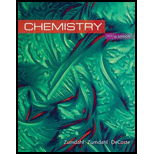
What are the two most abundant elements by mass in the earth’s crust, oceans, and atmosphere? Does this make sense? Why? What are the four most abundant elements by mass in the human body? Does this make sense? Why?
Interpretation: The two most abundant elements by mass in the Earth's crust, oceans and atmosphere are to be stated with a valid explanation. Also, the four most abundant elements by mass in the human body are to be stated with a valid explanation.
Concept introduction: The element that has the highest concentration (by mass) on the Earth is known as the most abundant element of the Earth.
To determine: The name of the two most abundant elements by mass in the Earth's crust, oceans and atmosphere with valid explanation; the name of the four most abundant elements by mass in the human body with a valid explanation.
Answer to Problem 1RQ
Answer
Oxygen and silicon are the two most abundant elements by mass in the Earth's crust, oceans and atmosphere.
Carbon, hydrogen, nitrogen and oxygen are the most abundant elements by mass in the human body.
Explanation of Solution
Explanation
Oxygen and silicon are the two most abundant elements by mass in the Earth's crust, oceans and atmosphere.
Yes, this makes sense. Earth’s crust contains silicon dioxide
Carbon, hydrogen, nitrogen and oxygen are the most abundant elements by mass in the human body.
Carbon, hydrogen, nitrogen and oxygen are the most abundant elements by mass in the human body.
Yes, this makes sense. The human body contains greater amount of protein and amino acids.
The composition of protein is carbon, oxygen and nitrogen. The main composition of amino acid is carbon, oxygen, hydrogen and nitrogen.
Conclusion
Since, Earth’s crust contains the highest concentration of silicon dioxide and ocean contains the highest concentration of oxygen. Hence, oxygen and silicon are the two most abundant elements in the Earth’s crust and ocean.
Since, the human body is basically composed of carbon, oxygen, hydrogen and nitrogen. Therefore, these are the most abundant elements by mass in the human body
Want to see more full solutions like this?
Chapter 20 Solutions
Chemistry
- The following reactions are all similar to those of the industrial chemicals. Complete and balance the equations for these reactions: (a) reaction of a weak base and a strong acid. NH3+HClO4 (b) preparation of a soluble silver salt for silver plating. Ag2CO3+HNO3 (c) preparation of strontium hydroxide by electrolysis of a solution of strontium chloride SrCl2(aq)+H2O(l)electrolysisarrow_forwardOut of white phosphorus and red phosphorus, which one is more reactive and why?arrow_forwardHow do Groups 1A(1) and 2A(2) compare with respect to reaction of the metals with water?arrow_forward
- How do atomic properties account for the low densities of the Group 1A(1) elements?arrow_forwardWhat is the role of (NH4)2HPO4? Give the balanced chemical equations for the reactions of Group IV cations with (NH4)2HPO4. Why was HCl added for the flame test of barium? What comprises Group IV Cations? Can precipitation give a positive test for this group? Why?arrow_forwardWhat safety precautions should be taken with selenium? I am preparing to remove selium from water using a sorbent. Why is selenium toxic and should be removed from water sources? How should a selenium and water solution be disposed of?arrow_forward
 ChemistryChemistryISBN:9781305957404Author:Steven S. Zumdahl, Susan A. Zumdahl, Donald J. DeCostePublisher:Cengage Learning
ChemistryChemistryISBN:9781305957404Author:Steven S. Zumdahl, Susan A. Zumdahl, Donald J. DeCostePublisher:Cengage Learning
 Chemistry: An Atoms First ApproachChemistryISBN:9781305079243Author:Steven S. Zumdahl, Susan A. ZumdahlPublisher:Cengage Learning
Chemistry: An Atoms First ApproachChemistryISBN:9781305079243Author:Steven S. Zumdahl, Susan A. ZumdahlPublisher:Cengage Learning Chemistry & Chemical ReactivityChemistryISBN:9781337399074Author:John C. Kotz, Paul M. Treichel, John Townsend, David TreichelPublisher:Cengage Learning
Chemistry & Chemical ReactivityChemistryISBN:9781337399074Author:John C. Kotz, Paul M. Treichel, John Townsend, David TreichelPublisher:Cengage Learning Chemistry & Chemical ReactivityChemistryISBN:9781133949640Author:John C. Kotz, Paul M. Treichel, John Townsend, David TreichelPublisher:Cengage Learning
Chemistry & Chemical ReactivityChemistryISBN:9781133949640Author:John C. Kotz, Paul M. Treichel, John Townsend, David TreichelPublisher:Cengage Learning Chemistry by OpenStax (2015-05-04)ChemistryISBN:9781938168390Author:Klaus Theopold, Richard H Langley, Paul Flowers, William R. Robinson, Mark BlaserPublisher:OpenStax
Chemistry by OpenStax (2015-05-04)ChemistryISBN:9781938168390Author:Klaus Theopold, Richard H Langley, Paul Flowers, William R. Robinson, Mark BlaserPublisher:OpenStax





